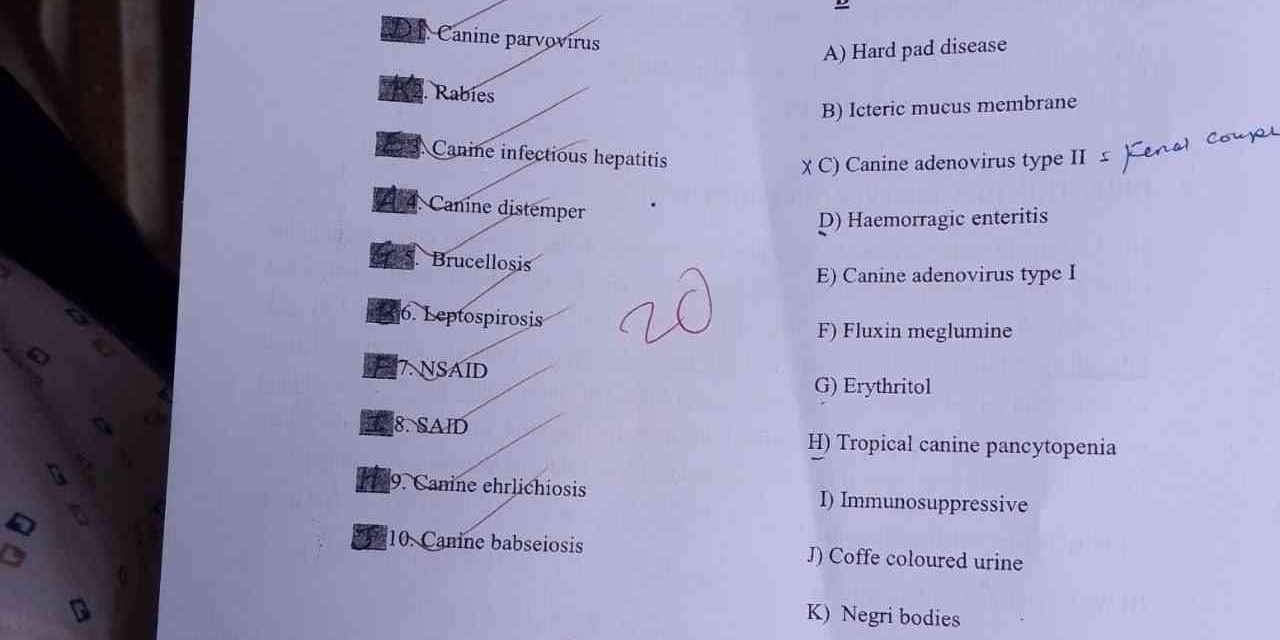Match the following canine diseases with their corresponding characteristics or treatments: 1. Canine parvovirus 2. Rabies 3. Canine infectious hepatitis 4. Canine distemper 5. Br... Match the following canine diseases with their corresponding characteristics or treatments: 1. Canine parvovirus 2. Rabies 3. Canine infectious hepatitis 4. Canine distemper 5. Brucellosis 6. Leptospirosis 7. NSAID 8. SAID 9. Canine ehrlichiosis 10. Canine babseiosis A) Hard pad disease B) Icteric mucus membrane C) Canine adenovirus type II D) Haemorragic enteritis E) Canine adenovirus type I F) Fluxin meglumine G) Erythritol H) Tropical canine pancytopenia I) Immunosuppressive J) Coffee colored urine K) Negri bodies

Understand the Problem
The image presents a matching question related to canine diseases and their associated characteristics or treatments. The goal is to match the disease on the left with the correct description or related term on the right.
Answer
Here are the matches based on the image provided: 1. Canine parvovirus - D) Hemorrhagic enteritis 2. Rabies - K) Negri bodies 3. Canine infectious hepatitis - E) Canine adenovirus type I 4. Canine distemper - A) Hard pad disease 5. Brucellosis - G) Erythritol 6. Leptospirosis - J) Coffee colored urine 7. NSAID - F) Fluxin meglumine 8. SAID - I) Immunosuppressive 9. Canine ehrlichiosis - H) Tropical canine pancytopenia 10. Canine babesiosis - B) Icteric mucus membrane
Here are the matches based on the image provided:
- Canine parvovirus - D) Hemorrhagic enteritis
- Rabies - K) Negri bodies
- Canine infectious hepatitis - E) Canine adenovirus type I
- Canine distemper - A) Hard pad disease
- Brucellosis - G) Erythritol
- Leptospirosis - J) Coffee colored urine
- NSAID - F) Fluxin meglumine
- SAID - I) Immunosuppressive
- Canine ehrlichiosis - H) Tropical canine pancytopenia
- Canine babesiosis - B) Icteric mucus membrane
Answer for screen readers
Here are the matches based on the image provided:
- Canine parvovirus - D) Hemorrhagic enteritis
- Rabies - K) Negri bodies
- Canine infectious hepatitis - E) Canine adenovirus type I
- Canine distemper - A) Hard pad disease
- Brucellosis - G) Erythritol
- Leptospirosis - J) Coffee colored urine
- NSAID - F) Fluxin meglumine
- SAID - I) Immunosuppressive
- Canine ehrlichiosis - H) Tropical canine pancytopenia
- Canine babesiosis - B) Icteric mucus membrane
More Information
Here is some additional information about the matching. Canine parvovirus often leads to hemorrhagic enteritis, causing bloody diarrhea. Rabies is characterized by the presence of Negri bodies in the brain tissue of infected animals. Canine infectious hepatitis is caused by canine adenovirus type 1 (CAV-1). Canine distemper can cause hyperkeratosis of the footpads, also known as hard pad disease. Brucellosis can be treated with Erythritol. Leptospirosis can cause coffee-colored urine due to kidney damage and the presence of blood and bilirubin. NSAIDs like Fluxin meglumine are used to reduce inflammation and pain. SAIDs are steroids and are known for their immunosuppressive effects. Canine ehrlichiosis, especially in tropical regions, can lead to tropical canine pancytopenia. Canine babesiosis can result in icteric mucous membranes (jaundice) due to the destruction of red blood cells.
Tips
Matching canine diseases with their characteristics often requires knowledge of veterinary medicine and pathology. It is important to understand the specific symptoms, treatments, and etiological agents associated with each disease.
Sources
- A review of immunologic diseases of the dog - PMC - PubMed Central - pmc.ncbi.nlm.nih.gov
- [PDF] QUESTION BANK - Maine.gov - maine.gov
- Infectious Canine Hepatitis - PMC - PubMed Central - pmc.ncbi.nlm.nih.gov
AI-generated content may contain errors. Please verify critical information